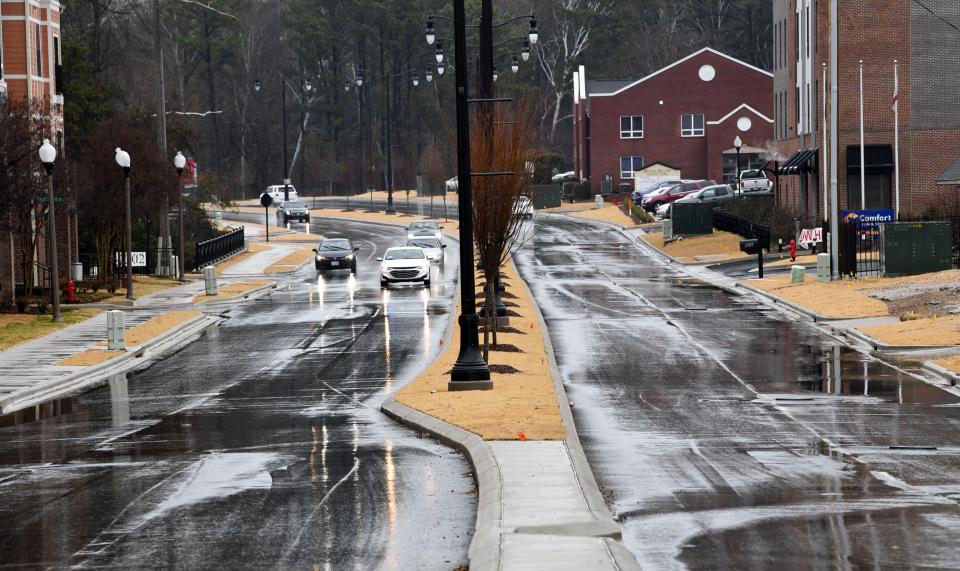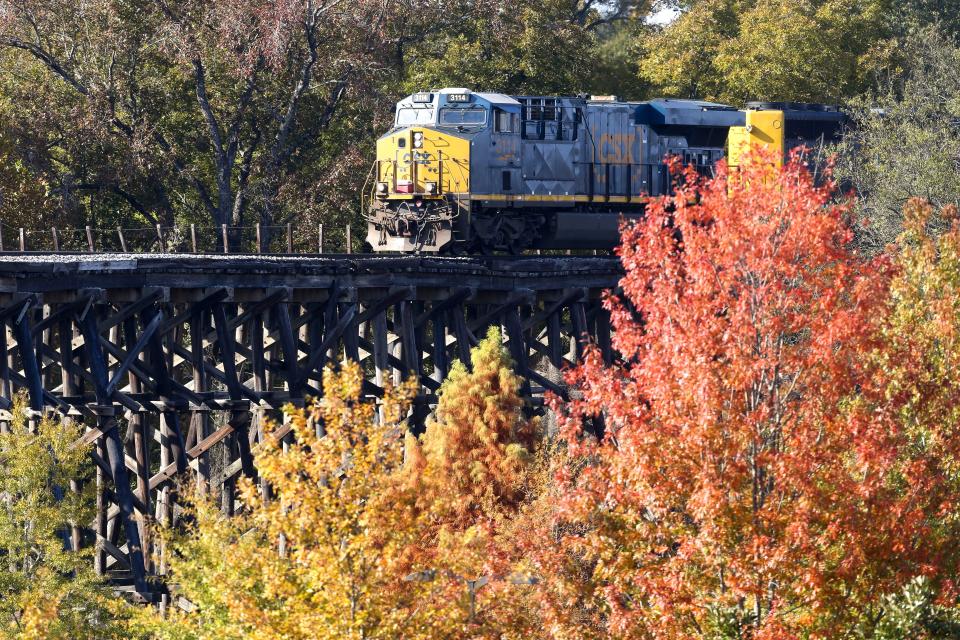Long-awaited Jack Warner Parkway Phase II extension/renovation ends
- Oops!Something went wrong.Please try again later.
After months of delay strung along by supply-chain problems and a variety of utility and site issues, the Phase II stretch of Jack Warner Parkway from Greensboro Avenue to 21st Avenue has now opened all four lanes.
Lumps and unevenness show in spots, with final layering and striping yet to be done, because for that, the project needs five to six days of guaranteed 50 degree or better weather, something in short supply this chilly January.
"We have to have that type of weather to put down the last layer of asphalt," said Mayor Walt Maddox.
NICK SABAN COMMEMORATIVE BOOK: Relive Nick Saban’s epic Alabama football coaching career with our special book! Preorder here.
Some holdups in completion have come down to factors such as that, where gravity and other forces of nature couldn't be urged along.
Geotech and old maps provided guidance, but sometimes, construction crews just had to dig in and see what was what, eight, 10 or 15 feet down. Utilities such as cable, electricity, water and sewer needed to be relocated as the road and pedestrian access expanded. So patience was required to do the job properly, the mayor said, as the city invests in infrastructure intended to serve Tuscaloosa for the next 50 years.
To downtown residents and drivers, closures may have seemed to linger longer than the roughly 18 months of Phase II, Maddox said, as Phase I preceded it, just across Greensboro Avenue.
"The first phase was from the train trestle to Greensboro, in front of the (Mercedes-Benz) Amphitheater," he said. "So if you're the public you really get this impression that this road has been closed for the last three years."

Work on Phase I began December 2020, and concluded in 2022, about the time Phase II began. At various times during Phase II, one snaking eastbound lane had been open, to allow access to businesses and residential areas, but drivers became used to navigating around the downtown construction.
Before this project began, those Phase I and II stretches of what was long known as River Road rumbled up, down and side-to-side like a poorly-made rollercoaster, having been laid out over bad soil, much of it landfill, in the 1960s. A look at Tuscaloosa maps of the early 20th century show wave-like ripples along the Black Warrior River banks. For decades the city sought to smooth those to a more level vehicular field, with varying success.
Phase II work involved:
Creation of a four-lane roadway divided by a landscaped median
Six-foot sidewalks along the north side of the parkway
Replacement of curbs and gutters
Decorative roadway and pedestrian lighting, landscaping, irrigation, security camera upgrades
Underground utilities repair and updates, while keeping those systems functioning
Duncanville-based GFC Construction Inc. performed utility, storm drain, roadway and private utility upgrades, as it did with Phase I. Phase III will extend the safety and other upgrades along Jack Warner Parkway going west of the train trestle, as it melds into Martin Luther King Jr. Boulevard at the southern bend, on to Stillman Boulevard.
![Road work on Jack Warner Parkway near the Tuscaloosa Amphitheater continues Thursday, July 15, 2021. Traffic will be complicated during the concert season at the Amphitheater. [Staff Photo/Gary Cosby Jr.]](https://s.yimg.com/ny/api/res/1.2/pjaqHH6sqm3n_Uv73LdM1Q--/YXBwaWQ9aGlnaGxhbmRlcjt3PTk2MDtoPTYyNA--/https://media.zenfs.com/en/the-tuscaloosa-news/00c563fff129170471c916a0f502b3bc)
At an August 2023 "State of the Community" session, about the time Phase II had originally hoped to be completed, Mayor Walt Maddox joked about it "doing its best imitation of the Lurleen Wallace Boulevard project in taking forever."
ALDOT was responsible for that earlier work, but many didn't make the distinction, so the city fielded complaints. Someone noted that renovation on Birmingham's infamous "Malfunction Junction," a messy knot of ramps and loops along I-20/59 approaching downtown, took less time than the Lurleen Wallace work.
"But you know why? They shut it down. If you could have shut down Lurleen Wallace Boulevard, you could have finished that project six months earlier," Maddox said, "but that wasn't an option."
Similarly, with the Jack Warner Parkway project, Tuscaloosa couldn't simply cut off all access to the Amphitheater, Hotel Indigo and other businesses and residences in the area. Utilities needed to continue flowing.
Current projections for the total enterprise are just over $79 million, according to Carly Standridge, the city's chief financial officer. Costs thus far have added up to $37,506,040.70. Phase III’s current construction estimate is $41,394,045. Other costs are anticipated outside the construction estimate, mainly Alabama Power utility and completion of the engineering contract for services during construction.
Costs encompassing the entire project don't have a phase assignment, such as design and engineering, right-of-way acquisition, security and traffic camera equipment purchases, debt issuance and ALDOT costs. Those totaled $13,625,727. Phase I construction totals equaled $16,326,390 while phase II has been $7,553,924.
Funding comes from City Hall, but is being reimbursed to taxpayers through a 2017 agreement with the Tuscaloosa County Road Improvement Commission. The two main ways:
The city issues debt, using its credit capabilities, and is paying that debt service biannually. TCRIC reimburses the city for those once per year. ThoseTCRIC payments equal about $1.9 million yearly, and will be fully paid off in 2051.
Early expenses, prior to debt issuance, were paid by the city, then reimbursed directly from TCRIC, for a total of $4,855,152.
House Bill 600, known as "Transforming Tuscaloosa County," was passed in July 2016, forming TCRIC, comprising elected and appointed representatives from governments and the private sector, and redistributing a portion of the 3% county-wide sales tax toward an investment fund to improve major transportation routes.
In addition to the Jack Warner Parkway/Martin Luther King Jr. Boulevard project, TCRIC's also overseeing the long-talked-about $65 million McWright's Ferry Road extension, which will open travel, residential and commercial opportunities north and east of Lake Tuscaloosa, along with work on Alabama Highway 69 and U.S. Highway 82, Bear Creek Cutoff and Mitt Lary Road.
More: Maps and other planning information for the Tuscaloosa County Road Improvement Project.
Tuscaloosa's largest infrastructure investment intends not just to level, widen and improve safety along Jack Warner Parkway/Martin Luther King Jr. Boulevard, but to remove open corridors to West End development, Maddox said.
"Too often that train trestle is a physical and psychological barrier to opportunities," Maddox said. "And to finally open that up, it's going to be transformative."
Phase III, final part of this project, will include two spur roads, and require widening of the train trestles. That part's been held up about 24 months as Kansas City Southern Railway negotiated with Canadian Pacific Railway. The former was purchased by the latter for $31 billion. The railroads merged April 14, 2023, to form Canadian Pacific Kansas City, with whom the city of Tuscaloosa is now in the final round of comments regarding design plans.

"We should be in business, I would think early summer, but could be earlier," Maddox said.
And naturally, all that physical and psychological barrier work must procede while letting the trains roll on.
"At times, it almost feels like Tuscaloosa ends at the amphitheater and the train trestle," the mayor said, "and that's not going to be the case, once that project is complete."
With the 21st century's Mercedes-Benz Amphitheater, River Market, Riverwalk, Parker-Haun Park and the upcoming Saban Center all springing up along the parkway — along with an attendant eruption of downtown hotels and other businesses — this artery will prove even more vital, connecting west Tuscaloosa with downtown, and the University of Alabama. The west side's economically distressed, with 37% of residents living below poverty level. Clearer, safer roadways are expected to help encourage economic development.
Reach Mark Hughes Cobb at mark.cobb@tuscaloosanews.com.
This article originally appeared on The Tuscaloosa News: All four lanes open after Phase II work ends on Jack Warner Parkway

